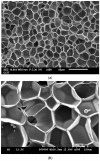The Application of Box-Behnken Design for Investigating the Supercritical CO2 Foaming Process: A Case Study of Thermoplastic Polyurethane 85A
- PMID: 38257276
- PMCID: PMC10820427
- DOI: 10.3390/molecules29020363
The Application of Box-Behnken Design for Investigating the Supercritical CO2 Foaming Process: A Case Study of Thermoplastic Polyurethane 85A
Abstract
Thermoplastic polyurethane (TPU) is a versatile polymer with unique characteristics such as flexibility, rigidity, elasticity, and adjustable properties by controlling its soft and hard segments. To properly design and understand the TPU foaming process through supercritical CO2, a design of experiments approach, the Box-Behnken design (BBD) was adopted using commercial TPU 85A as the model compound. The effect of saturation pressure, saturation temperature, and immersion time on the mean pore size and expansion ratio were investigated. The design space for the production of TPU foam was shown, and the significance of process parameters was confirmed using the analysis of variance (ANOVA). In addition, extrapolation foaming experiments were designed and validated the feasibility of the response surface model developed via BBD. It was found that the pore size of TPU 85A foam could be controlled within 13 to 60 μm, and a stable expansion ratio could be designed up to six.
Keywords: Box–Behnken design; supercritical CO2 foaming; thermoplastic polyurethane.
Conflict of interest statement
The authors declare no conflicts of interest.
Figures











Similar articles
-
Supercritical Fluid Microcellular Foaming of High-Hardness TPU via a Pressure-Quenching Process: Restricted Foam Expansion Controlled by Matrix Modulus and Thermal Degradation.Molecules. 2022 Dec 15;27(24):8911. doi: 10.3390/molecules27248911. Molecules. 2022. PMID: 36558060 Free PMC article.
-
Compression Molding of Thermoplastic Polyurethane Foam Sheets with Beads Expanded by Supercritical CO2 Foaming.Polymers (Basel). 2021 Feb 22;13(4):656. doi: 10.3390/polym13040656. Polymers (Basel). 2021. PMID: 33671823 Free PMC article.
-
Analysis of the Foaming Window for Thermoplastic Polyurethane with Different Hard Segment Contents.Polymers (Basel). 2021 Sep 17;13(18):3143. doi: 10.3390/polym13183143. Polymers (Basel). 2021. PMID: 34578043 Free PMC article.
-
Shape-Memory-Recovery Characteristics of Microcellular Foamed Thermoplastic Polyurethane.Polymers (Basel). 2020 Feb 6;12(2):351. doi: 10.3390/polym12020351. Polymers (Basel). 2020. PMID: 32041158 Free PMC article.
-
Liquid foaming of TPU with Methylal.Heliyon. 2024 Jun 6;10(12):e32420. doi: 10.1016/j.heliyon.2024.e32420. eCollection 2024 Jun 30. Heliyon. 2024. PMID: 39183888 Free PMC article.
Cited by
-
Characterization and Flame-Retardant Properties of Cobalt-Coordinated Cyclic Phosphonitrile in Thermoplastic Polyurethane Composites.Molecules. 2024 Apr 19;29(8):1869. doi: 10.3390/molecules29081869. Molecules. 2024. PMID: 38675689 Free PMC article.
References
-
- Chauvet M., Sauceau M., Fages J. Extrusion assisted by supercritical CO2: A review on its application to biopolymers. J. Supercrit. Fluids. 2017;120:408–420. doi: 10.1016/j.supflu.2016.05.043. - DOI
-
- Chen B., Jiang J., Li Y., Zhou M., Wang Z., Wang L., Zhai W. Supercritical fluid microcellular foaming of high-hardness TPU via a pressure-quenching process: Restricted foam expansion controlled by matrix modulus and thermal degradation. Molecules. 2022;27:8911. doi: 10.3390/molecules27248911. - DOI - PMC - PubMed
-
- Haurat M., Dumon M. Amorphous polymers’ foaming and blends with organic foaming-aid structured additives in supercritical CO2, a way to fabricate porous polymers from macro to nano porosities in batch or continuous processes. Molecules. 2020;25:5320. doi: 10.3390/molecules25225320. - DOI - PMC - PubMed
Grants and funding
LinkOut - more resources
Full Text Sources

